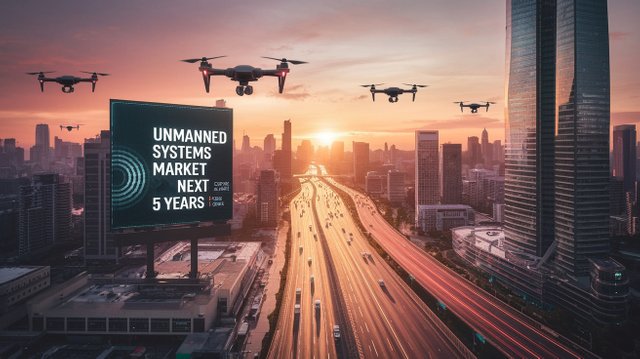Unmanned Systems Market Growth & Trends (2024-2030)

The unmanned systems market is rapidly evolving, revolutionizing industries across defense, logistics, agriculture, and research. These autonomous platforms, including unmanned aerial vehicles (UAVs), unmanned ground vehicles (UGVs), unmanned surface vehicles (USVs), and unmanned underwater vehicles (UUVs), are redefining how operations are conducted without human intervention.
In 2024, the global Unmanned Systems Market size was valued at USD 27.13 billion, and it is projected to reach USD 43.54 billion by 2030, growing at a CAGR of 8.2%. The demand for autonomous systems is increasing, driven by the need for intelligence, surveillance, and reconnaissance (ISR), target acquisition, and logistical efficiencies. However, the market faces challenges, including cybersecurity concerns, high costs, and complex regulations.
Market Growth Drivers
The Need for Advanced ISR and Target Acquisition Capabilities
One of the key drivers of the unmanned systems market is the increasing need for real-time intelligence, surveillance, and reconnaissance (ISR). Modern military operations depend on high-speed data acquisition and analysis to make strategic decisions. Platforms such as the MQ-9 Reaper and the RQ-4 Global Hawk play a crucial role in border surveillance, reconnaissance missions, and threat detection.
Unmanned systems are also becoming indispensable for target acquisition, integrating cutting-edge sensor technologies like:
- Electro-optical/infrared (EO/IR) cameras
- Synthetic aperture radars (SARs)
- Advanced communication networks
By combining these technologies, unmanned platforms enhance operational efficiency, reducing risks to military personnel while increasing precision in hostile environments.
Download Pdf Brochure: https://www.marketsandmarkets.com/pdfdownloadNew.asp?id=18210274
Rising Adoption in Commercial Sectors
Beyond defense, drone technology is becoming a crucial part of logistics, urban air mobility, and autonomous transportation. The commercial sector is witnessing an uptick in the use of drones for package delivery, agricultural monitoring, and industrial inspections.
For instance, companies are integrating drones into their supply chains to improve last-mile delivery, reducing transportation costs and increasing efficiency. Drone logistics and transportation will play a crucial role in shaping future smart cities and urban infrastructure.
Challenges in the Unmanned Systems Market
Cybersecurity Risks and Information Security Concerns
As unmanned traffic management becomes more widespread, concerns regarding data security and cyber threats have risen. These systems collect and transmit critical information, making them potential targets for hacking, jamming, and unauthorized surveillance.
For instance, military drones transmitting sensitive intelligence are vulnerable to cyberattacks that can compromise national security. As a result, governments and enterprises are investing in advanced encryption, secure communication channels, and AI-driven cybersecurity solutions to counteract these risks.
Regulatory and Compliance Barriers
The unmanned systems market faces significant regulatory hurdles, as different countries enforce varying restrictions on airspace usage, privacy concerns, and operational guidelines. Unmanned traffic management policies are still in development, and compliance with these evolving regulations is a major challenge for manufacturers and operators.
For instance, while the Federal Aviation Administration (FAA) in the US has established some guidelines for drone operations, cross-border drone regulations remain fragmented, limiting international commercial drone applications.
Opportunities in the Unmanned Systems Industry
Expanding Global Defense Budgets
The increase in defense spending worldwide presents a massive opportunity for the growth of unmanned systems. Governments are prioritizing military modernization, leading to higher investments in AI-powered autonomous systems.
Countries like the United States, China, and Russia are heavily funding next-generation defense technologies, including:
- Autonomous aerial combat vehicles
- AI-driven surveillance drones
- Robotic warfare solutions
The adoption of autonomous military drones has already reshaped modern warfare, reducing human casualties and increasing mission success rates.
Technological Advancements in Autonomous Systems
Technological breakthroughs in machine learning, artificial intelligence, and 5G-enabled communication systems are revolutionizing the unmanned systems market. With continuous improvements in sensor technology, real-time data processing, and AI-powered decision-making, the efficiency of autonomous vehicles is significantly increasing.
For example, AI-powered autonomous drones can now operate in high-risk environments, including disaster response operations, search and rescue missions, and precision agriculture applications.
Ask For Sample Report: https://www.marketsandmarkets.com/requestsampleNew.asp?id=18210274
Market Segmentation and Key Trends
By Type: The Dominance of Unmanned Aerial Vehicles (UAVs)
The unmanned aerial vehicle (UAV) segment is projected to reach USD 32.45 billion by 2030, with a CAGR of 7.2%. The increasing use of UAVs in military, commercial, and industrial applications is a key factor in this growth.
Drones are now widely used for:
- Border surveillance and military reconnaissance
- Agricultural monitoring and precision farming
- Drone-based logistics and transportation solutions
The rising demand for autonomous drone fleets will drive significant growth in this segment over the next five years.
By Region: North America to Dominate the Market
North America is set to be the largest market for unmanned systems, driven by substantial investments in defense, logistics, and commercial drone applications. The US remains a global leader in autonomous warfare technologies, with major defense firms like Lockheed Martin, Boeing, and Northrop Grumman leading the market.
Additionally, urban air mobility initiatives in the region are paving the way for autonomous passenger drones. Companies like Joby Aviation and Archer Aviation are actively working on developing electric vertical takeoff and landing (eVTOL) aircraft for future smart cities.
The Future of the Unmanned Systems Market
The next five years will witness unprecedented growth in unmanned systems, fueled by technological innovations, defense investments, and commercial sector adoption. While challenges such as cybersecurity threats and regulatory constraints persist, the opportunities outweigh the risks.
As drone technology, robotic warfare, and urban air mobility solutions continue to evolve, the unmanned systems market will shape the future of military operations, logistics, and smart city infrastructure. Companies investing in AI-driven autonomy, advanced sensor fusion, and resilient cybersecurity solutions will have a competitive advantage in this fast-growing industry.